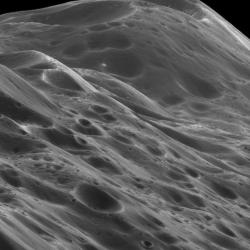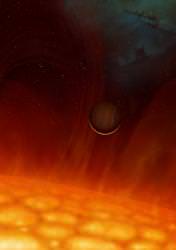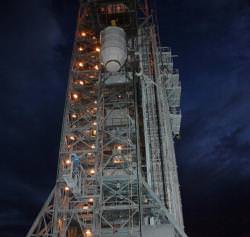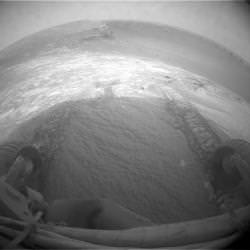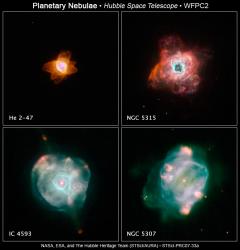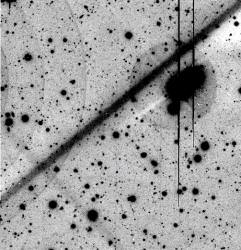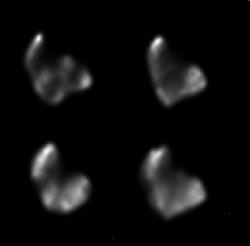In August 2002, a bizarre looking asteroid made its closest approach to the Earth, skimming only 540,000 km above the Earth’s surface. That’s only 1.5 times the distance between the Earth and Moon. This gave astronomers an unprecedented opportunity to study the asteroid as it zipped past. Perhaps its most unusual feature? It’s shaped like a triangle.
Asteroid 2002 NY40 was first discovered as part of the automated LINEAR system in New Mexico on July 14, 2002. And then, just a month later it made this closest approach, coming within 540,000 km of the Earth. As it approached, it gained in brightness, reaching as high as 8th magnitude – not visible with the unaided eye, but easy to spot with binoculars or a backyard telescope (if you knew where to look).
2002 NY40’s close approach was a rare event. Near Earth asteroids only get this close once every 50 years or so. The last asteroid to get this near was NEA 2001 CU11 which passed just outside the Moon’s orbit on August 31, 1925. And it wasn’t discovered for 77 years after it made the flyby – astronomers had to go back and calculate when it passed us by.
On the evening of August 17/18, 2002 NY40 was scheduled to make its closest approach. During this night, astronomers around the world, including a team of researchers from Boeing and the US Air Force focused in on it. The Boeing/Air Force team brought the 3.6 metre AEOS Adaptive Optics telescope in Hawaii to bear and studied the asteroid in unprecedented detail, revealing a tremendous amount of surface features. With all this data, they were able to better understand the physical makeup of the asteroid, and get an idea of its structure. Their results will be published in an upcoming issue of the journal Icarus.
Oh yeah, and it looks like a triangle.
The first observations were made with the Raven telescope located at the Remote Maui Experiment site at the base of Haleakala in Kihei, Hawaii. The telescope was configured so that it could track a fast moving object, like 2002 NY40 as it moved quickly through the telescope’s field of view. The researchers modified their exposure times dynamically – ranging from 15 seconds to 60 seconds – as the asteroid came and went. This allowed them to get the same amount of light for every image; it let them compare apples to apples.
Getting these high resolution images of the asteroid was actually pretty difficult. At its very brightest, closest point, when Asteroid 2002 NY40 could be seen at the greatest resolution, it was moving very quickly across the sky – it covered the diameter of the Moon every 6 minutes, zipping across the sky at 65,000 km/hour. The background stars changed with every image. Instead of calibrating against a single set of background stars, the researchers had to calibrate each image against whatever images happened to be in the field of view at the time.
Asteroid 2002 NY40 is tumbling. Its main rotation takes about 20 hours, and its secondary rotation takes about 18.5 hours. Living on this asteroid would be disorienting, to say the least.
According to the best images, 2002 NY40 is about 800 metres across. Once again, this was challenging to discern because the asteroid was casting shadows on itself for part of the flyby. Only at the moment of its closest approach, were astronomers able to get a good image showing its size. This team’s estimates are actually much larger than previous estimates, which calculated it being 250-450 metres.
It turns out, astronomers were quite lucky with the flyby. 2002 NY40 was perfectly positioned during its closest approach to present its largest face to the Earth. With this much data, the researchers were able to classify it as a Q-type asteroid; an uncommon class of inner-belt asteroids that have some metal in them.
And of course, one of the most amazing observations is its strange triangular shape. Getting these images out of the raw data was the hardest part. Lewis Roberts, one of the researches that did the work remarked that, “the imaging was the most challenging. It was a difficult object to acquire good data on and the raw data did not look great. The image processing was top notch and pulled out some good images.”
Original Source: Arxiv Paper
